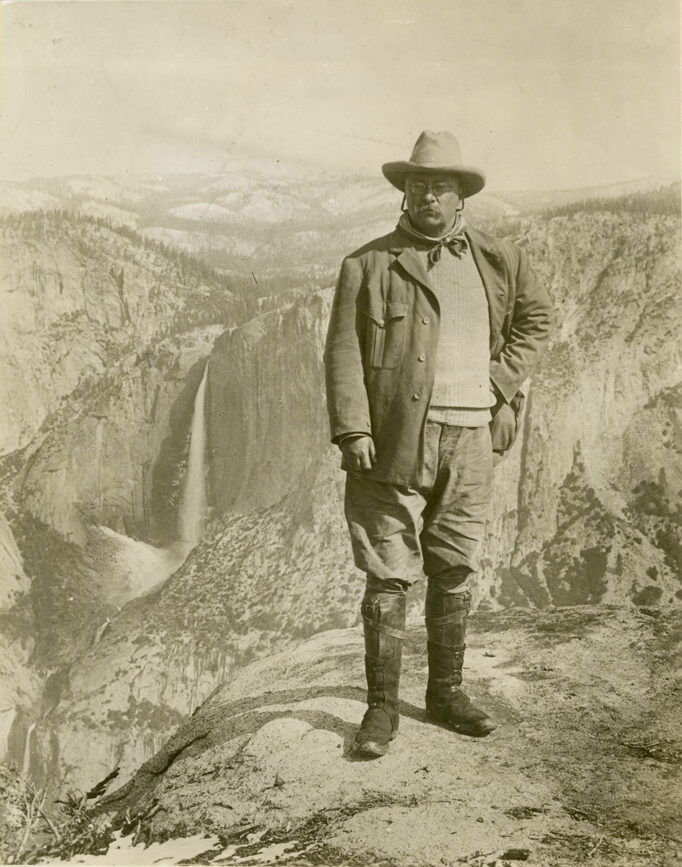California Stories

English Label
Underwood and Underwood, attributed
Untitled (Teddy Roosevelt at Yosemite), 1903 (printed c. 1930)
Gelatin silver print.
President Roosevelt stands on Glacier Point, Yosemite, in 1903. Compare his stance with that of the lumberjack in Otto Hagel’s photograph to the right. Both figures can be seen as conquering heroes of Manifest Destiny, the belief that European descents in the United States had the God-given right, even duty, to expand across the west, taking the land and forcing their values on Indigenous peoples.
This photographs of Roosevelt and the one of the lumberjack were created some 60 years apart and decades after the doctrine of Manifest Destiny was established, suggesting that the tents of Manifest Destiny had become ingrained in American values.
In arranging this visit to Yosemite, Roosevelt wrote to naturalist John Muir asking him to be his guide, saying, “I do not want anyone with me but you, and I want to drop politics absolutely for four days and just be out in the open with you.” According to the National Park Service, the visit resulted in Roosevelt expanding “federal protection of Yosemite, and it inspired him to sign into existence five national parks, 18 national monuments, 55 national bird sanctuaries and wildlife refuges, and 150 national forests.” – National Park Service
Another photograph was taken of Roosevelt standing with John Muir in the same location.
Spanish Label
Atribuido a Underwood y Underwood
Sin título (Teddy Roosevelt at Yosemite) [Teddy Roosevelt en Yosemite], 1903 (impreso c. 1930)
Impreso en gelatina de plata.
El Presidente Roosevelt parado en Glacier Point, Yosemite, en 1903. Compare su actitud con la de un leñador en la fotografía de Otto Hagel a la derecha. Ambas figuras pueden ser vistas como héroes victoriosos del Destino Manifiesto, la creencia de que los descendientes de europeos en los Estados Unidos tenían el derecho divino, incluso el deber, de expandirse a lo largo del oeste, tomando la tierra e imponiendo sus valores sobre los indígenas.
Estas fotografías de Roosevelt y la del leñador fueron creadas con 60 años de diferencia y décadas después de que se estableciera la doctrina del Destino Manifiesto, sugiriendo que las campañas del Destino Manifiesto se habían arraigado en los valores estadounidenses.
Mientras planificaba su visita a Yosemite, Roosevelt le escribió al naturalista John Muir pidiéndole ser su guía, diciendo, “No quiero que me acompañe nadie más que tú y quiero olvidarme de la política completamente por cuatro días y sólo estar al aire libre contigo”. De acuerdo con al National Park Service [Servicio Nacional de Parques], el resultado de la visita fue la expansión por parte de Roosevelt de la “protección federal de Yosemite y lo inspiró a firmar la creación de cinco parques nacionales, 18 monumentos nacionales, 55 santuarios nacionales para pájaros y refugios de vida silvestre y 150 bosques nacionales”. – Servicio Nacional de Parques
Se tomó otra fotografía de Roosevelt parado con John Muir en el mismo lugar.

